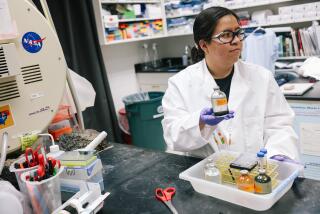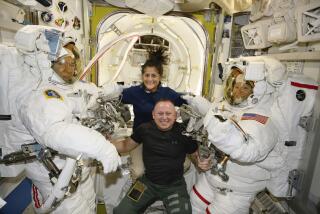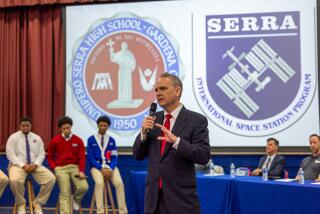Back on Track : CSUN Alumni Follow Up on Plans to Put Student Experiment in Space
- Share via
Some members of the Cal State Northridge Engineering School class of 1984 refuse to let their senior project go down in flames.
Almost 4 years after graduation, a band of alumni is pushing on with a plan to become the first California public college students to send a scientific experiment into space, a plan they once feared had died with the space shuttle Challenger.
On most Sunday afternoons, six members of the group meet back on the campus, working in a laboratory at the engineering school to complete the apparatus they began designing as students.
They still hope to launch it on a space shuttle, perhaps as early as February, in one of the “getaway specials” that NASA offers to schools, businesses and other government agencies. The specials accommodate scientific hitchhikers that NASA agrees to take aloft when space is available in vacant nooks and crannies of the shuttle.
“We were worried” after the Challenger exploded Jan. 28, 1986, said Jeff Craddock, 34. The students were afraid that there would be no more shuttle flights or that NASA would close down the getaway program, rendering years of work futile.
“But luckily, it’s still going strong,” said Craddock, leader of the alumni group. Even before the United States returned to space with the successful completion last month of the shuttle Discovery’s flight, the group heard from NASA that for those on the pre-explosion waiting list, “the small package program was still functioning and they wanted more paper work from us, so we got our butts back in gear.”
The additional paper work and stricter assembly requirements have been imposed on getaway specials since the Challenger disaster, he said.
“In some cases, they changed the forms, and we have to fill in new forms with the old data plus some more,” Craddock said. “In some cases, our wording may have been misleading, so we had to rewrite it.
“They have a series of reviews for every payload, and first you have to get it cleared by Goddard, and then by Johnson, and at every step of the way somebody wants to change the paper work, or even the hardware,” he said.
The program is administered by Goddard Space Flight Center in Greenbelt, Md., and Johnson Space Center in Houston.
A major problem for the group was a new rule that only Teflon-insulated electrical wires, “which are expensive and hard to come by,” could go aboard the shuttle, Craddock said.
“We’ve been pulling wires out on Sunday afternoons for about a month now,” he said. “It’s a tedious process. There’s about 100 of them.
“But they just want to make sure the system is safe, and if I were in their shoes, I’d be doing the same thing,” said Craddock, now an aerospace professional himself.
He went to work for Rockwell International after graduation, and has worked on the shuttle’s main engines, along with plans for a giant new booster rocket and the aerospace plane, the proposed passenger-carrying craft that would streak from city to city through the edge of space at speeds up to eight times faster than present jetliners.
Of the 12 students who signed up for the aerospace project for the spring term in 1984 (other seniors committed to automotive or energy projects), five have remained involved, Craddock said. All are now working as engineers for aerospace firms.
The others are Walter Waring of West Hills, Joan Yazejian of Los Angeles, Annette D. Boyce of Canoga Park and Henry Loureiro of West Hills--who came up with the idea for the group’s experiment, which involves melting metal in zero gravity.
They signed up a sixth recruit from CSUN’s class of 1986, David Collins of Glendale.
Their experiment is aimed at proving that metal melted in the zero gravity of space will form a perfect sphere, as theory holds that it should, which could point the way to manufacturing ball bearings in space some day.
Although the idea has been batted around in scientific publications for some time, no one has yet actually conducted the experiment with metals, Craddock said.
The attraction, Craddock has said, is that it is impossible to create a perfect sphere of metal on Earth. Gravity always deforms it in some way, and attempting to correct the shape by grinding or polishing introduces yet other imperfections. Because of this, Earth-manufactured ball bearings--which are so crucial to manufacturing and transportation that German ball bearing factories were a key target of Allied bombers in World War II--are imperfect to at least a very slight degree.
Unknown Experiments
NASA spokesmen said they were unsure whether other researchers have carried out such an experiment. The West German government has sent a number of materials-handling experiments aloft on a shuttle, said Clark Prouty, a Goddard center administrator, “but we don’t know if they did specifically this same experiment.”
“We’ve tried to keep up on all the research and as far as we can tell, nobody has done precisely what we’re doing,” Craddock said.
Metals have been melted in space by other researchers, “but that was for the purpose of studying the grain or crystal structure as they cooled.”
Perfect spheres were formed by NASA by melting latex rubber in space, he said, “but not metals. And their spheres were made to serve as laboratory standards, one micron in size. A micron is smaller than a pinhead, almost invisible. Our metal cubes are thousands of times as big.”
For the getaway specials, NASA provides canisters in two sizes, 5 cubic feet or 2.5 cubic feet, which “look like aluminum garbage cans with ends that bolt on, sealed with O-rings,” said Jack Gottlieb, senior NASA technical manager for the getaway program at the Goddard center.
The getaway experiments are supposed to be self-contained and internally controlled, needing little attention from astronauts in orbit. A mission payload specialist can be asked to flip a switch on the outside of the can at the proper time if need be, but otherwise the apparatus inside the can must be capable of performing the experiment.
Low Melting Point
The heart of the alumni team’s experiment is a small, battery-powered oven containing “about a coffee cup full” of wax, Craddock said. About a dozen small cubes of a metal alloy, of from one-eighth to three-eighths of an inch on a side, are scattered through it “like raisins in a cake,” Craddock said. The alloy consists of tin, lead and bismuth and was chosen for its low melting point.
Once the shuttle is in orbit “and things have quieted down--we’re going to ask them to do this just before the crew goes to sleep”--an astronaut will switch on the experiment, Craddock said. The oven will melt first the wax, and then, as the temperature rises to 205 degrees Fahrenheit, the metal.
A thermostat and a control board improvised from a $40 home computer that one of the students bought in a drugstore will then turn off the heat. The metal will cool, floating in wax and untouched by any solid object. It will then, if the experiment is successful, produce perfect spheres.
Physical theory holds that a liquid in a gravity-free environment forms a perfect sphere under the pressure of its own surface tension, because the sphere provides the minimum surface area for a given volume.
Students from Caltech, a private school, flew a getaway special experiment more than 4 years ago. And although there are “about 50” California university-based researchers and student groups on the waiting list, none are as far advanced in the complicated acceptance process as the CSUN group, Gottlieb said.
“It’s difficult to predict when any of these projects will fly,” Gottlieb said, but of the 485 projects on NASA’s waiting list, the CSUN group “is somewhere in the first 20.”
Cutbacks in Getaways
NASA no longer takes reservations for the getaway specials, and the number per flight has fluctuated between two and 13, Gottlieb said. Since the Challenger explosion, NASA has cut back on the number of getaway special packages scheduled in an effort to lessen the weight of the shuttle, Craddock said. The earliest their apparatus could fly would be on a flight scheduled for February, he and Gottlieb agreed.
NASA has tentatively planned to provide space for more than a dozen getaway specials on a flight scheduled for July, 1990, and the CSUN canister would almost certainly be among that group if it does not make an earlier flight, Gottlieb said.
The group owes its place not only to its own efforts--an applicant’s standing in the waiting list depends partially on how diligently they prepare their apparatus and comply with the paper work requirements--but also to a gift from Tom Hanes, a retired TRW engineer. Hanes paid $500 for a place on NASA’s list in 1980 and donated it to the school. The spot--it was No. 91--did not guarantee a booking on a shuttle flight, only a place on the priority list to talk to NASA about it.
The alumni group expects to complete the project on a budget of less than $6,000. They started out with $650 raised from the school and from donations by the original 12 student members.
The project won them a $500 award from the Lincoln Arc Welding Foundation and a grant of $1,800 from the CSUN Foundation. A grant of $3,000 from Industrial Tectonics of Dominguez Hills, will cover the fee NASA charges for paper work once the experiment has a guaranteed place on a shuttle manifest.
“That should be enough to fly,” Craddock said.
More to Read
Sign up for Essential California
The most important California stories and recommendations in your inbox every morning.
You may occasionally receive promotional content from the Los Angeles Times.










